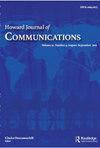Donald Trump’s America: Communicating the Seeds of Racism, Xenophobia, & Persistent Conflict
IF 0.8
Q3 COMMUNICATION
引用次数: 0
Abstract
President Donald John Trump served as America’s 45th President for one term, from January 2017 to January 2021, and his tenure was remarkable for incline in overt racism, xenophobia, and other social conflicts. That it ended in one term, given that three Presidents who served before him all served for the maximum two terms defined America’s response to his service. Although Donald Trump was voted out by America, his mark persists and the imprint significant and deep that it may take years for America to recover and move toward civil communication across racial divisions and returning to the era of America as a land accepting immigrants. It is notable that Trump’s presidency will forever be remembered for building a large and lengthy wall designed to keep away immigrants from crossing the Southern border with Mexico while the border in the North was never open to a debate of closure or immigrant restriction. The meaning was, particularly, on the issue of race and it was obvious to many. At the Northern border was a largely Caucasian Canadian population and at the South was the non-Caucasian Mexicans. But the closure or restriction of physical border to the South would pale in its inhumanity to the treatment of children whose parents were separated from them and housed in locations described as concentration camps where they were detained in cages. Vinopal (2019) reports were collateral in Trump’s decision to stop the Deferred Action for Childhood Arrivals (DACA) program affected 1.2 million persons and that the program would lead to the loss of $4 billion in lost taxes. But beyond xenophobia, with race undertones, are racial upheavals within the country. Therefore, it is unsurprising that this special issue features articles addressing race and immigration, primarily. Donald Trump stoked the racial fire, within the country, via various communication even before he became America’s 45th President. He claimed that the then 44th President Barack Obama was not American, and Trump led the birther campaign against Obama’s Presidency (Kelley-Romano & Carew, 2018/19). Wilkie (2020) of the CNBC reported President Trump’s blistering attack of the Black Lives Matter (BLM) movement for highlighting police killing of African Americans across the country. According to Isom et al. (2021); Trump frequently employed the trope of “White victim” in attacking the BLM. They conclude that “The mitigating effects of Trump support and patriarchal gender normative beliefs suggest holding such sentiments likely normalizes perceived ‘victimhood’ and anti-BLM sentiments.”唐纳德·特朗普的美国:传播种族主义、仇外心理和持续冲突的种子
唐纳德·约翰·特朗普总统是美国第45任总统,任期为2017年1月至2021年1月,他的任期因公开的种族主义、仇外心理和其他社会冲突而引人注目。考虑到在他之前的三位总统都担任了最长的两届任期,这就决定了美国对他的服务的回应。尽管唐纳德·特朗普被美国人民投票淘汰,但他留下的印记依然存在,而且影响深远,以至于美国可能需要数年时间才能恢复元气,走向跨越种族分歧的文明交流,回到美国作为一个接受移民的国家的时代。值得注意的是,特朗普的总统任期将永远被人们记住,因为他修建了一堵又大又长的墙,旨在阻止移民越过南部与墨西哥的边境,而北部边境从未开放过关于关闭或限制移民的辩论。这句话的意思,特别是在种族问题上,对许多人来说是显而易见的。北部边境主要是加拿大白种人,南部是非白种人墨西哥人。但是,关闭或限制通往南方的实体边界,与对待那些父母与他们分离、被关在集中营、被关在笼子里的儿童相比,就显得不那么不人道了。Vinopal(2019)的报告是特朗普决定停止影响120万人的“儿童入境暂缓遣返”(DACA)计划的附带条件,该计划将导致40亿美元的税收损失。但在带有种族色彩的仇外心理之外,是这个国家内部的种族动荡。因此,这期特刊的文章主要讨论种族和移民问题也就不足为奇了。唐纳德·特朗普甚至在成为美国第45任总统之前,就通过各种沟通在国内煽动种族之火。他声称当时的第44任总统巴拉克·奥巴马不是美国人,特朗普领导了反对奥巴马总统任期的出生地运动(Kelley-Romano & Carew, 2018/19)。美国全国广播公司CNBC的威尔基(2020年)报道说,美国总统特朗普猛烈抨击“黑人的命也是命”运动,指责警察在全国范围内杀害非洲裔美国人。根据Isom et al. (2021);特朗普在攻击BLM时经常使用“白人受害者”的比喻。他们得出结论:“特朗普的支持和父权性别规范信念的缓解作用表明,持有这种情绪可能会使感知到的‘受害者’和反blm情绪正常化。”
本文章由计算机程序翻译,如有差异,请以英文原文为准。
求助全文
约1分钟内获得全文
求助全文
来源期刊

Howard Journal of Communications
COMMUNICATION-
CiteScore
2.70
自引率
10.00%
发文量
23
期刊介绍:
Culture, ethnicity, and gender influence multicultural organizations, mass media portrayals, interpersonal interaction, development campaigns, and rhetoric. Dealing with these issues, The Howard Journal of Communications, is a quarterly that examines ethnicity, gender, and culture as domestic and international communication concerns. No other scholarly journal focuses exclusively on cultural issues in communication research. Moreover, few communication journals employ such a wide variety of methodologies. Since issues of multiculturalism, multiethnicity and gender often call forth messages from persons who otherwise would be silenced, traditional methods of inquiry are supplemented by post-positivist inquiry to give voice to those who otherwise might not be heard.
 求助内容:
求助内容: 应助结果提醒方式:
应助结果提醒方式:


